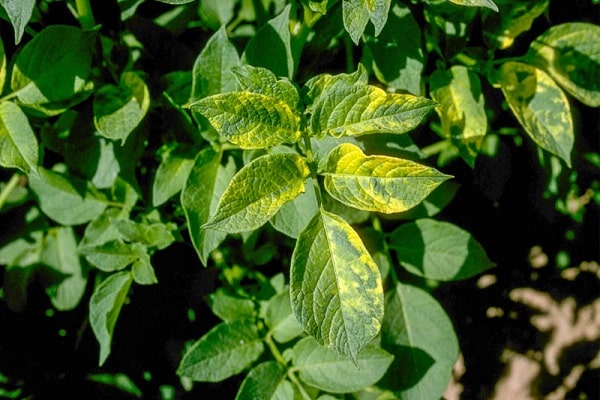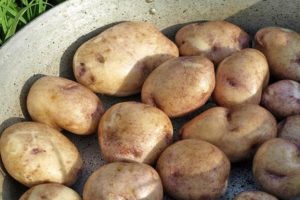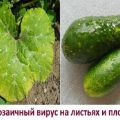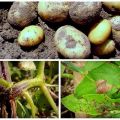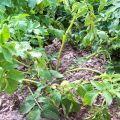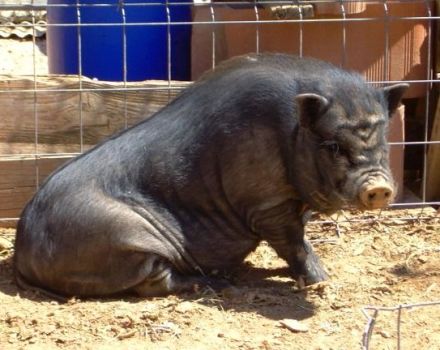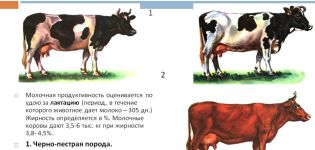Description, symptoms and treatment of potato wrinkled mosaic
It is not easy to grow potatoes on the site, in addition to standard agrotechnical methods for care, treatment of plants from diseases is required. Plants affected by this disease have wrinkled leaves. It is not easy to deal with it, you should determine the beginnings of the disease in time and try to eliminate it as quickly as possible. Otherwise, crop losses can be 30% or more.
Features of the course of the disease, symptoms
Among themselves, summer residents call the disease "curliness". Symptoms are especially severe only for 3 years. Plant height becomes much lower than that of healthy bushes. To correctly identify the disease, you need to carefully look at the external deformations of the leaves of the culture. Due to a lack of moisture, foliage tissues develop unevenly. As a result, bumps and wrinkles are formed. The leaves of the potato brighten, curl and die off, but do not fall off. The plant itself withers.

Bush stems affected by wrinkled mosaic are unable to retain moisture. Therefore, they quickly dry up and die. The growing season in a diseased plant is reduced by 3-4 weeks. As a result, the tubers grow small, the yield is significantly reduced.
Diseased potato bushes practically do not bloom.
When examining plants, it is important not to confuse wrinkled mosaics with other types of this disease. In addition, the defeat of the bush is not one, but several types of mosaics in combination.
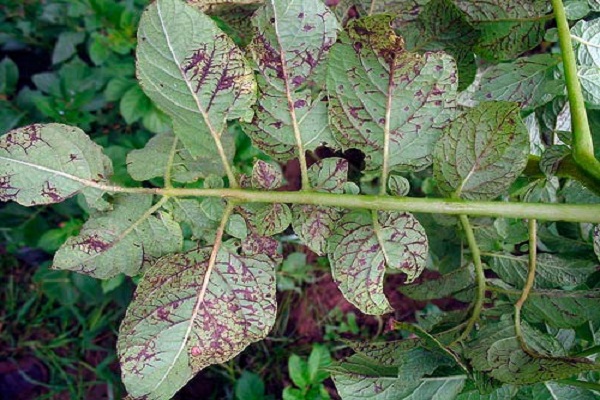
Favorable conditions for development
The active development of wrinkled mosaic is observed in the southern regions, where stable hot weather lasts most of the growing season. But plants are also affected by this disease in other regions where the heat is for a long time.

Carriers of the disease
The first year, the disease practically does not manifest itself, but the viruses winter well in the tubers. And next year they are hit with greater intensity. Mosaic of aphids and other insect-sucking pests are transferred. In addition, the pathogen lives in weed grass, eating the leaves of which, insects transfer the disease to healthy potato bushes.
Mechanical processing of tubers, before planting or when performing other work on the site, can also transfer the virus from a sick potato to a healthy one. Therefore, you should carefully use garden tools, or disinfect them.
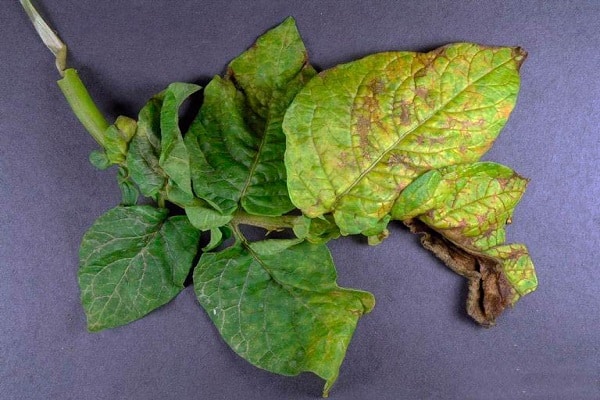
How to treat potato wrinkled mosaic?
The description of potato wrinkled mosaic does not suggest multiple treatment for the disease. There are no effective folk methods of struggle.
The focus is on preventive measures:
- Use 100% healthy planting material.Tubers for seeds are selected right on the site, so the summer resident knows better which bushes were healthy during the growing season. When germinating seed material, those tubers, sprouts of which have deformation are immediately rejected. They contain the virus, which then spreads throughout the site.
- Seed potatoes be sure to pickle before disembarking.
- If the slightest signs are found in plants, immediately dig it up and destroy it, the bushes are burned or buried deep in the ground, in which pathogenic viruses die.
- Fight against carriers of the disease, aphids and the Colorado potato beetle, cicadas and other insects. For this, plants are treated with special chemicals.
- Weed the beds regularly, removing weeds.

Do not use chemicals. At present, an effective means of combating this scourge has not yet been developed. Therefore, you should not, to the detriment of your body, get too carried away with useless remedies.
Summer residents' tips on how to deal with wrinkled mosaic of potatoes
A young gardener who first encountered this disease is experiencing difficulties. He seeks advice from more experienced people who not only faced the mosaic, but were also able to defeat it. All growers are advised to take healthy planting material and closely monitor the plants. Carry out phyto-cleaning several times during the growing season. That is, remove all diseased and slightly affected plants.
Sergei Stepanovich: “I have been working in a vegetable garden for a long time and I have encountered mosaic wrinkling in my time. The main thing that I want to advise is prevention and timely detection of the disease. It is better to dig up a bush affected by the disease and burn it, or take it away from the site. Unfortunately, I still cannot distinguish sick tubers from healthy ones ”.
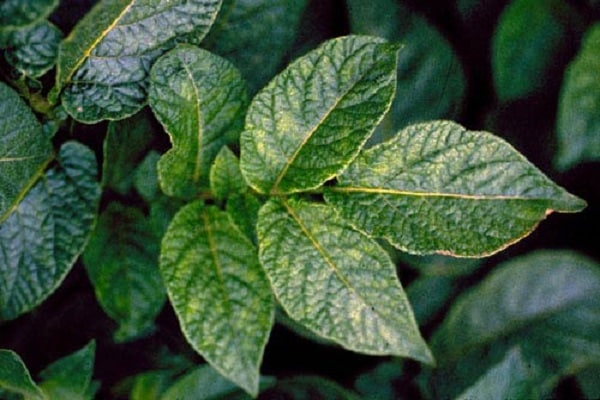
Petr Ivanovich: “The first thing I want to note is that the disease is practically invisible. An inexperienced vegetable grower will not be able to identify it so easily. Some summer residents confuse wrinkling with late blight. I myself do not always identify it immediately. But I pay great attention to the selection of seed material. I notice healthy bushes in advance, choose tubers for seeds, from them. Therefore, the disease does not bother much. "
Alexandra: “I know firsthand many types of potato mosaics. I advise everyone to take a closer look at the appearance of plants. Those bushes, the leaves of which are covered with wrinkles, immediately pull out and take away from the site. They are struck by wrinkled mosaics. The first years I confused the diseases, now I can tell them straight away. I select the seeds myself, I do not trust anyone, I observe the crop rotation, so we rarely encounter a disease ”.
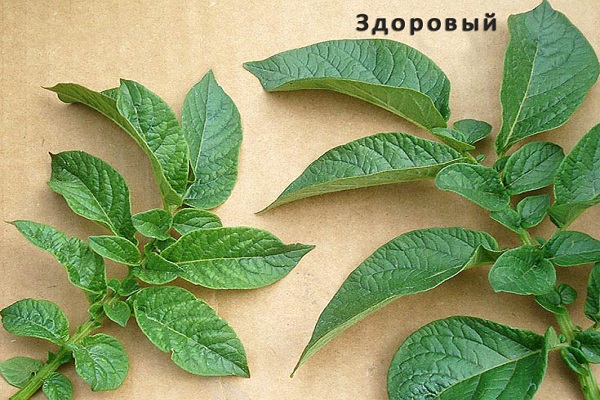
Types of potato mosaics
For young summer residents who are just starting to grow a crop on the site, it will be useful to know the symptoms of other types of mosaics.
The correct diagnosis can only be made in the laboratory.

- Striped mosaic of potatoes. The leaves and stems are covered with spots or stripes. On the inside, between the veins, brown spots are formed. Symptoms are initially seen on the middle leaves, then the top foliage and stem are spotted. It is carried by aphids and other insects. The virus is transmitted during processing or cuts with garden tools.
- Mottled mosaic of potatoes. Another name for the disease is ordinary mosaic. As a result of the disease, yield losses are 12–45%. Symptoms are visible on young leaves and appear as mottling or mosaic spots. Plants are lagging behind in growth. It is transferred by contact and with the help of insects. In addition to potatoes, tomatoes, tobacco, nightshade, henbane and other plants are affected.
- Folded mosaic of potatoes. The leaves become folded or wavy. First they brighten and then take on a shade of bronze. In case of intensive infestation, the yield loss is 40%.
- Aucuba mosaic. Symptoms appear on the top leaves of the potato. If damaged, they lose 40% of the crop. If the virus overwintered in tubers, there are no symptoms at all in the second year.
- Rustling mosaic. It is carried by aphids. Therefore, first of all, the symptoms appear on the upper leaves. They begin to curl around the midrib, the inner side becomes silvery. The leaves wither and dry up, which is why they rustle in the wind. The overwintered virus first infects the lower leaves, with a yield loss of 70%.
- Contrast figured mosaic. The leaves on the bushes begin to turn yellow. Then they become stained, the edges die off. Brown necrotic spots appear on the stalks and petioles of potatoes. Massive damage to plants will lead to a loss of 80% of the crop.

The disease wrinkled mosaic of potatoes is difficult to destroy on the site, so you need to carefully monitor the condition of the beds. Timely removal of diseased plants will save them from mass infection. It is better to burn the bushes affected by the disease, in order to avoid a repeated outbreak of the virus and its further spread.
